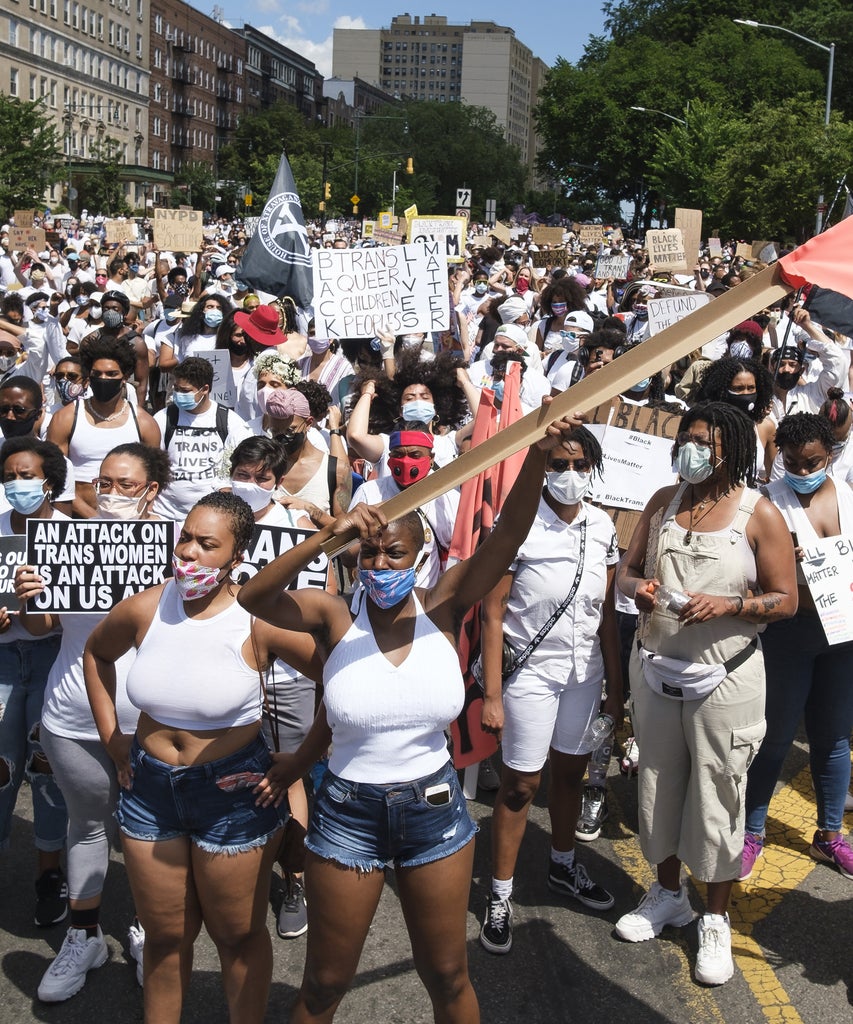
On Sunday, over 15,000 people made their way to the Brooklyn Museum to support the Black Trans Lives Matter movement. The demonstration took place after multiple Black trans people, including Dominique “Rem’mie” Fells, Riah Milton, Tony McDade, and Layleen Cubilette-Polanco, were killed. Coming together to honor Black trans lives, nearly everyone in attendance was wearing white.
In doing so, the group sent a powerful message, one that is steeped in historical significance.
In 1917, following racial tensions and violent attacks on the Black community by white people in St. Louis, Missouri, the NAACP organized what is now known as the 1917 Silent Protest Parade, a march that took place on Fifth Avenue in Manhattan on July 28. During the demonstration, a group of 10,000 attendees held signs that read, “Make America safe for democracy” and “We march because we deem it a crime to be silent in the face of such barbaric acts,” according to the Association’s website — signs not much different from those of recent weeks prompted by the deaths of George Floyd, Breonna Taylor, Ahmaud Arbery, and more Black people at the hands of the police.
Photos from the Silent Protest Parade also show women and children wearing white.
According to a tweet by Fran Tirado, one of the organizers of Sunday’s demonstration, that’s where the idea to ask attendees to follow suit came from. “Ten days ago, West Dakota called me with idea,” the tweet says. West Dakota, a drag queen from Brooklyn, is one of Tirado’s fellow organizers. “A Brooklyn-based protest creating space and action for Black trans lives. She referenced a New York protest in 1917 when the NAACP assembled 10,000 all wearing white standing up against anti-Black violence.”
Ten days ago, West Dakota called me with idea. A Brooklyn-based protest creating space and action for Black trans lives. She referenced a New York protest in 1917 when the NAACP assembled 10,000 all wearing white standing up against anti-Black violence. #brooklynliberation pic.twitter.com/NlzecJrolU
— Fran Tirado (@fransquishco) June 15, 2020
White was meant to replace rainbow, a color scheme that has been associated with Pride, but, in recent years, has been capitalized on by corporations. In the LGBTQ+ community, the concept is known as pinkwashing: the meaningless marketing and political strategies used by companies to feign support for LGBTQ+ people. As GQ notes, even the police are guilty of it, hanging rainbow flags outside of its precincts, all the while killing innocent Black queer people. The irony, given Pride’s history as a protest aimed against police, is not lost on anyone.
“THE REVOLUTION IS NOW. PINKWASHING IS OVER. RAINBOW CAPITALISM IS OVER. NO PERMIT, NO WORKING WITH COPS. NO PRIDE FOR SOME OF US WITHOUT LIBERATION FOR ALL OF US,” Dakota wrote on Instagram.
White, as the article points out, acts as a blank slate for the Black trans community. “Another part of our incentive for folks to wear white was to help the public understand a new, visual way to imagine our community — the dawn of a new era that would not just include Black Trans and gendernonconforming people, but put them at the front where they belong,” Tirado told GQ. In wearing white, it also allowed the community to remove the former significance associated with the rainbow so as to stop others from using it to their advantage. In the article, Tirado adds that now, rainbow — and Pride month in general — has been co-opted by white, cis people, the one group the month is not meant to celebrate. On the contrary, white stands out, Dakota added.
The result was extremely powerful, as seen in images and videos taken from the occasion. However, some believe it wasn’t enough. One Instagram user @moniquelmm called on her followers to do more for the Black trans community in the caption of a photo from the protest. “Black & brown trans folks led (and continue to lead) movements for both LGBTQ+ and black rights. Yet we fail to give them the respect and recognition they deserve,” the caption reads. “Black trans people are consistently left out of discussions involving queer, black, and/or feminist issues, yet they are the most profiled and susceptible minorities. The media and the government are constantly deadnaming them, overlooking their cases, undermining the violence they endure, and even denying them simple rights such as equitable healthcare.”
Still, as Tirado says, “this is the largest trans-based protest in history.” And with protests continuing to take place all around the world, this movement is only getting bigger.
To help bring attention to the police killing of George Floyd, you can sign the Change.org petition here, or donate to local organizations like Black Vision Collective or Reclaim the Block via the Minnesota Freedom Fund here.
Like what you see? How about some more R29 goodness, right here?
What To Wear (& Not Wear) When Protesting

No comments:
Post a Comment